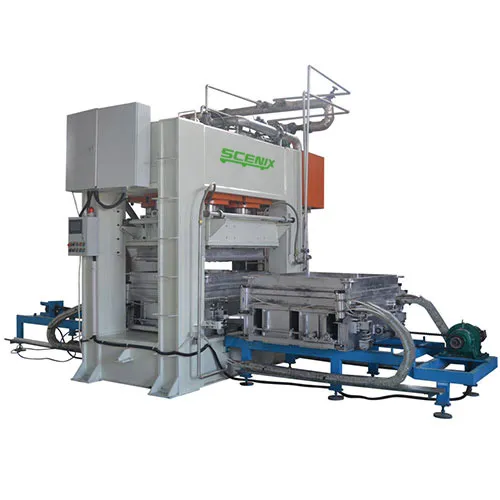Call Us
+86-15192680619
Email Us
info@ecopallet.cn
The characteristics of compositiond wood pallet
2023-06-30
Composite wood pallets, also known as engineered wood pallets or presswood pallets, are pallets made from a combination of wood fibers, adhesive resins, and sometimes other materials. These pallets are designed to provide a lightweight, durable, and cost-effective alternative to traditional wooden pallets. Here are some characteristics of composite wood pallets:
Material Composition: Composite wood pallets are typically made from a mixture of wood particles or fibers, such as sawdust, wood chips, or wood shavings. These wood fibers are combined with a binding agent or adhesive resin, which holds the fibers together and provides structural integrity.
Lightweight: Composite wood pallets are generally lighter in weight compared to solid wood pallets. The use of wood particles and resins allows for a more efficient use of materials, reducing the overall weight of the pallet.
Consistent Dimensions: Composite wood pallets are manufactured with precise dimensions and consistent thickness. This allows for uniform stacking and easier handling during transportation and storage.
High Strength-to-Weight Ratio: Despite being lightweight, composite wood pallets offer good strength and load-bearing capacity. The combination of wood fibers and adhesive resins provides structural stability and enables the pallets to withstand heavy loads.
Resistance to Moisture and Insects: Composite wood pallets are often treated or manufactured with additives that enhance their resistance to moisture, rot, and insect infestations. This makes them suitable for use in humid or damp environments.
Uniformity: Composite wood pallets are manufactured using molds or presses, which ensures consistent shape, size, and structural integrity across multiple pallets. This uniformity allows for efficient handling, stacking, and storage.
Sustainability: Composite wood pallets are often made from recycled or waste wood materials, reducing the demand for new timber. They can contribute to sustainability efforts by utilizing wood by-products that might otherwise go to waste.
Customization Options: Composite wood pallets can be manufactured in various sizes, configurations, and load capacities to meet specific customer requirements. They can also be designed with additional features such as anti-slip surfaces, forklift entry points, or special reinforcements.
Compliance with Regulations: Composite wood pallets can be engineered to meet industry standards and regulatory requirements such as ISPM 15 (International Standards for Phytosanitary Measures), which governs the treatment of wood packaging materials to prevent the spread of pests and diseases.
It's important to note that the specific characteristics of composite wood pallets may vary depending on the manufacturing process, the type of wood fibers and adhesives used, and any additional treatments or additives applied during production.
Material Composition: Composite wood pallets are typically made from a mixture of wood particles or fibers, such as sawdust, wood chips, or wood shavings. These wood fibers are combined with a binding agent or adhesive resin, which holds the fibers together and provides structural integrity.
Lightweight: Composite wood pallets are generally lighter in weight compared to solid wood pallets. The use of wood particles and resins allows for a more efficient use of materials, reducing the overall weight of the pallet.
Consistent Dimensions: Composite wood pallets are manufactured with precise dimensions and consistent thickness. This allows for uniform stacking and easier handling during transportation and storage.
High Strength-to-Weight Ratio: Despite being lightweight, composite wood pallets offer good strength and load-bearing capacity. The combination of wood fibers and adhesive resins provides structural stability and enables the pallets to withstand heavy loads.
Resistance to Moisture and Insects: Composite wood pallets are often treated or manufactured with additives that enhance their resistance to moisture, rot, and insect infestations. This makes them suitable for use in humid or damp environments.
Uniformity: Composite wood pallets are manufactured using molds or presses, which ensures consistent shape, size, and structural integrity across multiple pallets. This uniformity allows for efficient handling, stacking, and storage.
Sustainability: Composite wood pallets are often made from recycled or waste wood materials, reducing the demand for new timber. They can contribute to sustainability efforts by utilizing wood by-products that might otherwise go to waste.
Customization Options: Composite wood pallets can be manufactured in various sizes, configurations, and load capacities to meet specific customer requirements. They can also be designed with additional features such as anti-slip surfaces, forklift entry points, or special reinforcements.
Compliance with Regulations: Composite wood pallets can be engineered to meet industry standards and regulatory requirements such as ISPM 15 (International Standards for Phytosanitary Measures), which governs the treatment of wood packaging materials to prevent the spread of pests and diseases.
It's important to note that the specific characteristics of composite wood pallets may vary depending on the manufacturing process, the type of wood fibers and adhesives used, and any additional treatments or additives applied during production.
Previous:What is Presswood Pallet Equipment?
X
We use cookies to offer you a better browsing experience, analyze site traffic and personalize content. By using this site, you agree to our use of cookies.
Privacy Policy
























































